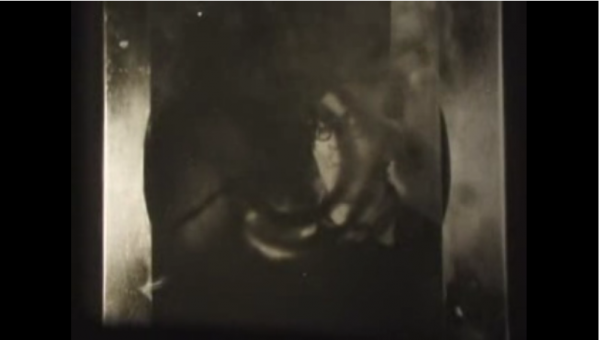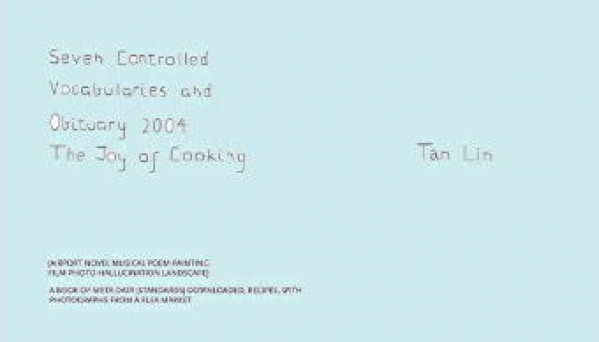The above text comes from the front cover—which coincidentally serves as the backcover—of Tan Lin’s Seven Controlled Vocabularies and Obituary 2004. The Joy of Cooking. The text is only half of the metadata supplied, an excerpt from the Library of Congress “tags” that establish the content of the book officially. Lin’s book is a rhizome, a network, it is a book as a book, it is a book as a network as a book, it is a book as a book as a book.
Okay, let me start over. There are two ways one can approach Lin’s book. Of course, there are actually an infinitude of entrances to Lin’s book, but for the sake of this blog post, to ensure that it does come to an end, I will discuss two: the way I expected to enter the book and the way I actually entered the book.
How I expected to enter the book:
There are two prominent (ish) reviews of Lin’s book on the internet right now: Dan Visel’s review on his blog and Maureen Thorsen’s review, which has been linked from here before. Of course, when I say these are the two prominent reviews on the internet I should note that I have not actually bothered to look for any others. I guess I might after I finish writing this post. The point is, there are some really smart reviews of this book available on the internet. I read the Visel review a month before I read Lin’s book, and I read the Thorsen review the day after.
Lin’s book is conceptual writing, a conceptual book. Like I said, it is a book as a book. The idea of the book is very important to Lin’s book. If I had any forethought, I would have brought Fitterman & Place’s Notes on Conceptualisms for reference here, because it’s a pretty amazing & oblique guide that makes more sense the more conceptual writing you read. Regardless, the fact that Lin’s book is a conceptual book, and the fact that I knew this, gave me the expectation that the experience of reading Lin’s book would be mostly guided by this tangential outside information that Visel’s review had provided.
Visel’s review offers occasional explanations towards the books various sections, contextualizing the book within the context of a larger set of books written (or at least compiled) by Lin, pointing out a connection between the book’s second section (A Field Guide to The American Landscape) & Hollis Frampton’s equally oblique, though conceptually more transparent, (nostalgia). Really, Visel’s review itself serves as information that furthers the book after a reading, similar to the way that documents created by Lin himself in the form of POD books stretch the book into an expanded experience.
By the time I got a copy of the book and read it, I had completely forgotten Visel’s review.
How I actually ended up entering the book:
The book arrived in a padded envelope, I opened the package, I opened the book, I began reading. Ultimately, the experience of the book became what I was concerned about. The joy of the words on the page targeted a fairly niche interest I have in theoretical & technical language (specifically of the hard sciences) in relationship to abstracted ideas and, often, meaninglessness. Allow me to provide some examples:
[As anyone] [who has spent time on the Las Vegas strip] can tell you,
FUSE
there is minimal enclosure and negligent direction.
This comes from a section entitled “BOOKS That Function As BUILDINGS”. The opposite page features four tiny images of what seems to be the back of art books, the text mostly obscured. Ultimately, what any of this specifically means is lost to me, as it is, perhaps, lost to most readers of the book. I can safely make the assumption that Lin knows what this means, all of it, together. This is not problematic, from my perspective.
Lin’s book is a highly heterogeneous in form. The obtuseness may prevent the reader from achieving any direct meaning, and all but specific (potentially) autobiographical fragments related to cooking refuse any sort of character-driven empathy (for this is, largely, a narrative without characters), but ultimately the reading experience is what counts. Lin’s book is a book that privileges experience above all else. The form of the book, the variations, the ideas, all insist upon it.
Perhaps my favorite section of the book is the third section, “American Architecture Meta Data Containers.” Its use-value can be found in the presentation of ideas on the book, language, literature, the text. But if we are reading this book as a philosophical text it fails to do anything beyond suggest. There are ideas, but they are not developed, or even explored. They are simply presented. Within the landscape, the architecture of the book, these ideas serve as guides to the exploration of the text.
“Architecture as Shelter with Decoration on It”
vs.
“Literature as Space with Language Attached to It.”
Refusing to accept the architecture/book comparison as purely metaphorical, textual markings that recall concrete poetry decorate the book like ornamentation. Letters left alone, rare punctuations float in white space: the page is not performative, it is literally space that holds something inside of it.
There are also a lot of pictures throughout the book. Black and white, mostly small, often impenetrable in their details. I don’t really know what the images do, but I’m glad they’re in the book. Often the inclusion of extra-textual elements in a book, particularly when there can be no direct necessity for these elements found, is referred to as gimmicky. Lin’s extra-textual elements can in no way be described as gimmicky, as, if anything, they obscure meaning more than they reveal it, and as a gimmick is intrinsically present to “increase appeal,” well, it seems like the general audience of Books doesn’t specifically find obliqueness appealing. What these elements do is refuse to let the book exist as any book exists. They insist upon an examination of the book while the book continues to exist as a book.
Ultimately, I think, this is why the book is successful. It insists upon it’s place in the world as a book, yet it exists more as a unique & heterogenous experience than as anything mimetic or representational (which is how fiction is generally expected to act). This contrast heightens Lin’s book to the level that it exists at, and while I’m not sure exactly how to describe that level autonomously, it is a future for the book that I hope more books take a cue from.
Of course, within this blog post I have not reached any conclusions that I give that much support to. Rather, I hop around from idea to idea mentioning things that have excited me about Lin’s book. It makes more sense to me, really, to write about Seven Controlled Vocabularies… this way, because trying to approach this book from a homogeneous, organized point would violate what the book itself achieves.
PLATE 4
My girlfriend thinks the world is constantly taking its own picture and walking away from it.
Tags: Seven Controlled Vocabularies, tan lin, The Book



i thought for a bit, trying to come up with an analogy that could be used to explain the gravitas of this post to someone who just simply wouldn’t get the context – the ‘joke’ – being less-than-subtly/obliquely referred to… and this is what i came up with:
imagine a well groomed and kept dog throws up in the middle of a dog park. all the other dogs naturally take notice and thereby come over and huddle to look intently (with neutral facial expressions, no doubt) at the throw up. they gaze at its consistency, its texture. meanwhile, the dog that has just thrown up joins the pack in staring at the throw up. this post is that throw up.
please, let me know if i’m in the right ballpark here.
damnit, i already feel bad about posting this.
neutral […] they gaze
Really?? The other bowsers dive in, don’t they? Num num!
eyeballs eat words, brah
You sure that’s the correct order of consumption?
neutral facial expressions? Isn’t that a Tao Lin thing? I thought Tan Lin was an entity unto himself?
this is a truth
tan lin is not tao lin
http://www.poetryfoundation.org/harriet/2010/04/poetics-of-distribution-metadata-as-poesis-tan-lins-7cv-edit-processing-network-publishing/
i told you people way smarter than me are writing about this, thanks for the link steven!
[…] Vocabularies… – Tan Lin My only commentary I have recorded anywhere on this is the post I made a while […]